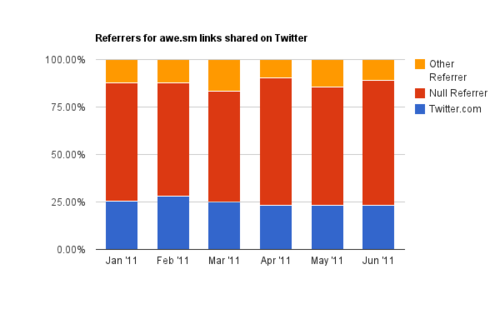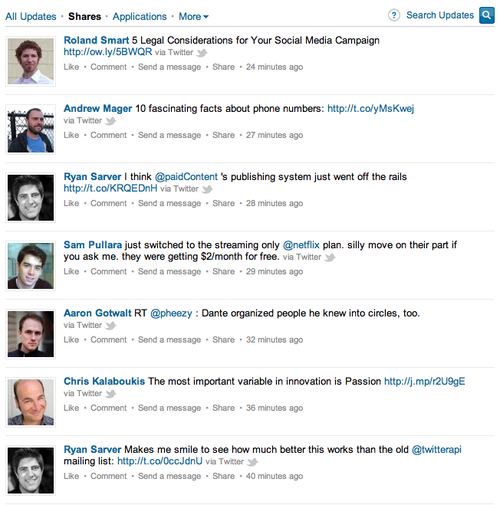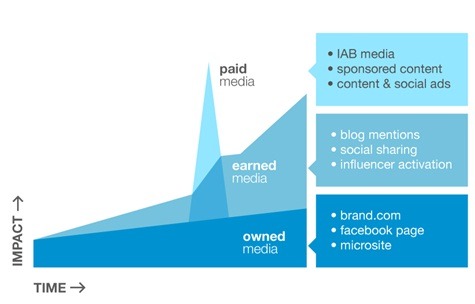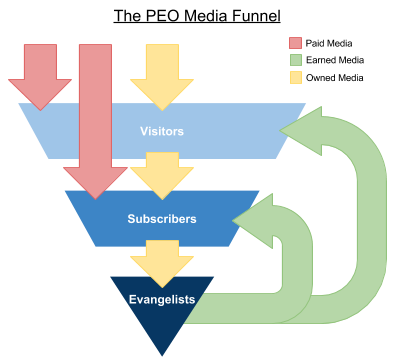Over the last few weeks, TechCrunch has run a couple posts using their own referrer logs to measure how sharing on various social services drives traffic. In these and other analyses based solely on referrer information, Twitter performs surprisingly poorly relative to expectations many of us have based on our own observations of the volume of link sharing on Twitter.
Does that mean the people you follow on Twitter who share links all the time are that atypical? Do most normal people just not click on links in Tweets? Is LinkedIn far more popular with the rest of the world than it seems to be with the people you know?
No, no, and no. There is a much simpler answer behind this disparity: referrers are a poor way to attribute traffic from social sharing.
Referrer analysis is based on the outdated metaphor of the web as a network of links between static pages that could only be navigated by browsers. Today’s web is built around social streams and other APIs that are consumed via dynamic web applications, desktop clients, mobile apps, and even other web services, all of which render referrers obsolete as an attribution mechanism.
awe.sm was built for the modern web — a network of people, not pages — to track the results of Tweets, Likes, emails, and other sharing activities no matter what path they follow. So our system knows with certainty where each link was originally shared in addition to all the places where it was ultimately clicked (i.e. referrers). This approach gives us a unique set of data that demonstrates just how misleading referrer information can be.
And in the case of links shared on Twitter, it’s very misleading: the referral traffic one sees from Twitter.com is less than 25% of the traffic actually driven by Twitter.
Twitter is the perfect storm for referral traffic
We looked at awe.sm data from the first 6 months of 2011 spanning links to over 33,000 sites, and the numbers were astounding:
- only 24.4% of clicks on links shared on Twitter had twitter.com in the referrer;
- 62.6% of clicks on links shared on Twitter had no referrer information at all (i.e. they would show up as ‘Direct Traffic’ in Google Analytics);
- and 13.0% of clicks on links shared on Twitter had another site as the referrer (e.g. facebook.com, linkedin.com).

Twitter is the quintessential modern web service — all the ways to consume Twitter, even Twitter.com, are just clients for the Twitter API — so the failure to effectively track it using such an outmoded methodology as referrer analysis should come as little surprise. Twitter’s openness and the many resulting ways users interact with it are what have made it so successful, but they are also the things that have made its value largely invisible to publishers.
‘Direct Traffic’ explained
When a user clicks a link in any kind of non-browser client, from Outlook to a desktop AIR app to the countless mobile and tablet apps, no referrer information is passed for that visit and your analytics software basically throws up its hands and puts the visit in the ‘Direct Traffic’ bucket. The assumptions behind this fallback behavior show just how arcane referrer analysis is — if a visit didn’t come from another webpage (i.e. no referrer data), someone must have typed the URL directly into their browser address bar.
How Twitter sends traffic through other sites
If you’ve spent the last few years wondering why the proportion of ‘Direct Traffic’ to your site has been on the rise, the answer is the growing usage of non-browser clients, especially on mobile. And since 2/3 of Twitter consumption is happening in desktop and mobile clients*, it’s safe to say that a lot of your ‘Direct Traffic’ is actually coming from Twitter.
While the incredible growth of mobile apps and desktop clients and their importance in the Twitter ecosystem is news to no one, the value Twitter drives through content syndication is a bit more surprising: more than 1 in 8 visits driven by Twitter sharing are actually referred from other sites. Many other sites use Twitter’s API to pull in Tweets that they display on their own sites, where links in those Tweets are then clicked.

For example, look at this screenshot of my LinkedIn activity stream. Notice that every update says ‘via Twitter.’ Yet when someone clicks on one of those links, the referrer will be linkedin.com, even though it only got to LinkedIn because someone shared it on Twitter first.
The same is true of Tweets syndicated to Facebook, About.Me, and myriad other websites that allow users to connect your Twitter feed directly. And because Twitter’s API is open and most Tweets are public by default, there are also many applications and sites that display Tweets based on hashtags, search terms, and other criteria without a user ever needing to connect their own feed.
In addition to the programmatic syndication of Tweets through Twitter’s API, sharing is fundamentally social and the human element is responsible for much of the serendipity that makes social media so powerful. A great example of that is this Tweet by @zeyneparsel, who only had 144 followers at the time. However, she happens to be a self-proclaimed “veteran hipsterologist” and this Tweet was on the subject of hipsterism (?!). As a result, the link contained in her Tweet ended up being included in a Psychology Today blog post on hipsterism (see UPDATE 3), which drove a significant amount of traffic.
In these cases, which showcase the amplification effect that makes Twitter so uniquely valuable to publishers and marketers, analyzing referrer data alone would attribute traffic to a variety of other sites, even though it all originated with sharing on Twitter.
Improving social attribution
Last week, MG Siegler noted that Google+ started rewriting all outbound clicks to come from plus.google.com. Facebook has rewritten outbound links for quite a while due to phishing/malware and privacy concerns. And both LinkedIn and StumbleUpon frame all external pageviews, which means you can see all the views they drive. As t.co rolls out to 100% of the links shared on Twitter (a topic we’ve previously covered in some depth), they may very well start rewriting all clicks on t.co links to show Twitter as the referrer. This would ensure Twitter gets the credit they deserve for traffic they send to publishers, but it would have the downside of obfuscating the diverse paths that a tweeted link can take.
Until then, it’s possible to correctly attribute visits driven from Twitter sharing by tagging your outgoing links using a solution like Google Analytics campaign tracking parameters. For example, the Tweet Buttons on Business Insider use links like this:
http://www.businessinsider.com/closing-bell-july-12-2011-7?utm_source=twbutton&utm_medium=social&utm_term=&utm_content=&utm_campaign=moneygame
Google Analytics can then properly attribute traffic to those buttons. Google Analytics offers a handy URL Builder tool, and other analytics solutions, like Omniture, support similar campaign tracking parameters of their own.
Why awe.sm is, well, awesome 
And if all you want is an accurate count of the aggregate traffic Twitter drives to your site, that should be enough. But our customers have found there’s a lot more value to be had in understanding the mechanics that drive successful sharing — who is tweeting, what they’re tweeting, where it’s being tweeted from, when it’s being tweeted, etc. So in addition to automatically building the outbound links to integrate our social attribution with Google Analytics, Omniture, and other web analytics solutions, awe.sm tracks the performance of each Tweet (and Like, etc) individually. By connecting the rich information we have about the context of each share with the visits, pageviews, conversions, and revenues it drives, we enables our customers to go beyond just looking at social data and to start acting on it (and to build cool stuff like this).
If you’re interested in learning more about how awe.sm can help your business harness the value of social, please drop us a line here.
* The full list of sources of clicks with no referrer information (i.e. ‘Direct Traffic’) not only includes mobile and desktop clients, but also web-users who have https security enabled for their Twitter accounts (which strips out referrer information).
*Content originally published on the awe.sm blog.







Recent Comments